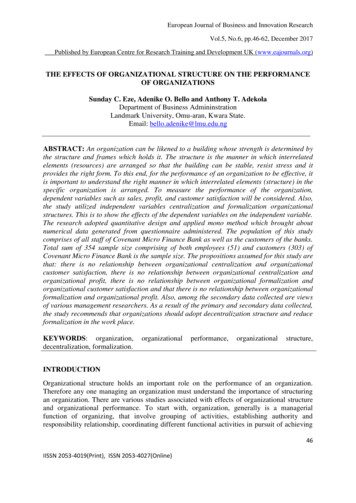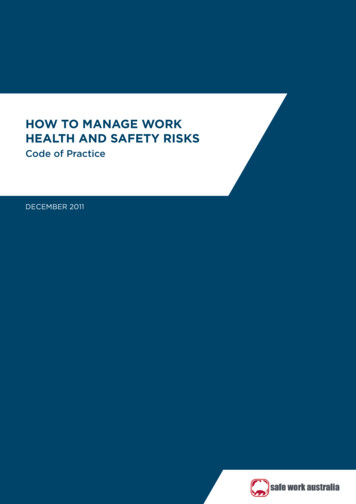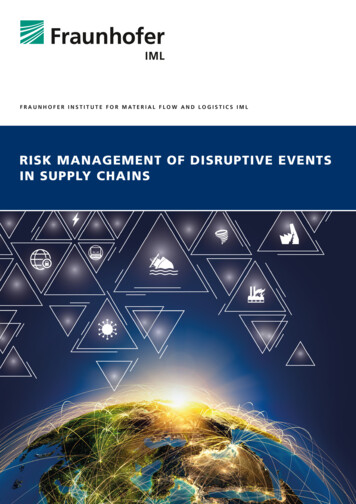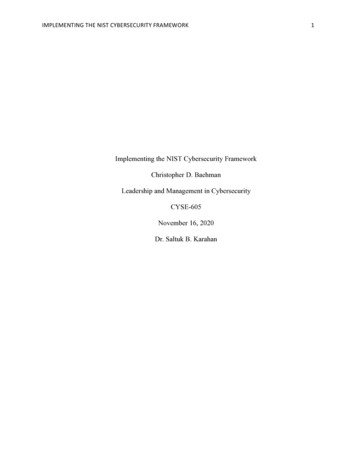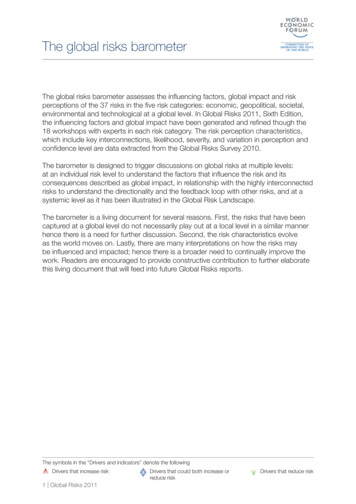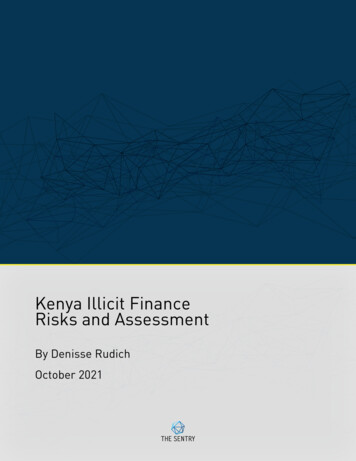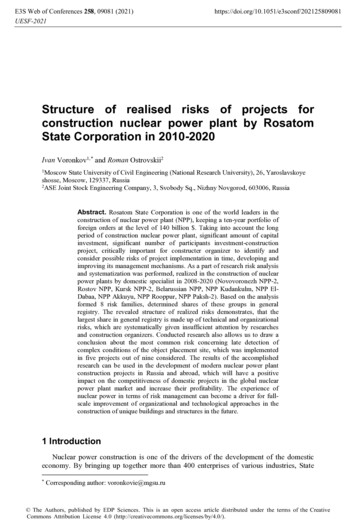
Transcription
E3S Web of Conferences 258, 09081 125809081Structure of realised risks of projects forconstruction nuclear power plant by RosatomState Corporation in 2010-2020Ivan Voronkov1, * and Roman Ostrovskii21Moscow State University of Civil Engineering (National Research University), 26, Yaroslavskoyeshosse, Moscow, 129337, Russia2ASE Joint Stock Engineering Company, 3, Svobody Sq., Nizhny Novgorod, 603006, RussiaAbstract. Rosatom State Corporation is one of the world leaders in theconstruction of nuclear power plant (NPP), keeping a ten-year portfolio offoreign orders at the level of 140 billion . Taking into account the longperiod of construction nuclear power plant, significant amount of capitalinvestment, significant number of participants investment-constructionproject, critically important for constructer organizer to identify andconsider possible risks of project implementation in time, developing andimproving its management mechanisms. As a part of research risk analysisand systematization was performed, realized in the construction of nuclearpower plants by domestic specialist in 2008-2020 (Novovoronezh NPP-2,Rostov NPP, Kursk NPP-2, Belarussian NPP, NPP Kudankulm, NPP ElDabaa, NPP Akkuyu, NPP Rooppur, NPP Paksh-2). Based on the analysisformed 8 risk families, determined shares of these groups in generalregistry. The revealed structure of realized risks demonstrates, that thelargest share in general registry is made up of technical and organizationalrisks, which are systematically given insufficient attention by researchesand construction organizers. Conducted research also allows us to draw aconclusion about the most common risk concerning late detection ofcomplex conditions of the object placement site, which was implementedin five projects out of nine considered. The results of the accomplishedresearch can be used in the development of modern nuclear power plantconstruction projects in Russia and abroad, which will have a positiveimpact on the competitiveness of domestic projects in the global nuclearpower plant market and increase their profitability. The experience ofnuclear power in terms of risk management can become a driver for fullscale improvement of organizational and technological approaches in theconstruction of unique buildings and structures in the future.1 IntroductionNuclear power construction is one of the drivers of the development of the domesticeconomy. By bringing up together more than 400 enterprises of various industries, State*Corresponding author: voronkovie@mgsu.ru The Authors, published by EDP Sciences. This is an open access article distributed under the terms of the CreativeCommons Attribution License 4.0 (http://creativecommons.org/licenses/by/4.0/).
E3S Web of Conferences 258, 09081 125809081atomic energy Corporation «Rosatom» (State corporation, Rosatom) at the momentrealizing 11 investment and construction projects [1,2] construction of nuclear power plantsat the same tima, 7 of them are abroad. Annually declared volumes of the StateCorporation s ten-year project portfolio remain quite high (more than 140 billions formid-2020), and Rosatoms s foreign revenue for 2019 amounted more than 7 billion [3]despite significant economic changes taking place in developed and developing countries.According to some researchers opinions, nuclear power construction is also one of themost effective means of building an innovative society in Russia [4] by the strengtheningits leading positions in the world in the segment of construction and maintenance of nuclearenergy facilities (OUAE) [5].A significant contribution to the promotion of the Russian Federation interests in theglobal nuclear power plant market has made a significant devaluation of the nationalcurrency along with a scientific and technical potential of the domestic nuclear, whichstimulated exports [6] and defind the high profitability of construction energy blocks NPPby Russian specialists. However, this factor is a time-limited and cannot be used in the longterm.In order to resolve this issue and in an effort to bring the efficiency and quality of itsactivities to the level of advanced international standarts, Rosatom imports the world s bestmanagement practices actively. Risk management technologies are no exception [7]. Thisdirection of activity is carried out both at the level of the State Corporation, the Engineeringdivision [8], and within each NPP construction project, which results in the formation andupdating of risk registers [9], which are a source of extremely requested information aboutcritical features of the implementation of NPP construction projects.Each construction project of a modern nuclear power plant is unique. Despite thesimilarity in the power plant and in the set of basic equipment, the construction process ofpower units of various nuclear power plants differs significantly. The reasons for this areboth the specific features of the power plant site, non-standard customer requirements, andthe current political context [10]. The situation is even more aggravated in the context ofthe manifestation of differences in the legislation and the regulatory framework of the clientcountry and the executing country. Multiplied by a long implementation period and asignificant amount of capital investment [11], these features clearly demonstrate the highrelevance of systematic improvement of all aspects of NPP construction projectimplementation without exception, including risk management.Over the past decade, the scientific literature has repeatedly raised the theory andpractice of large-scale implementation of risk management in the process of NPPconstruction management. Researchers have repeatedly decomposed risks in nuclear powerconstruction into groups: emergency, financial and environmental [13] and categories:political and regulatory; technical; commercial and financial [13], however, in theoverwhelming majority of studies, priority attention was paid to the analysis of financialand economic risks affecting the overall profitability of projects. At the same time, risks ofa technical and organizational nature were not considered and were not studied in depth.In addition to this, it should be noted that in the scientific literature studies that aredevoted to the risk analysis that were realized on specific NPP construction projects anddirectly influenced the final result of construction are practically absent.The lack of statistic and analytical materials on this issue in some ways reflects a shift inthe attention of management structures from organizational and technological to financialand economic aspects of the implementation of projects for the construction of power unitsof modern nuclear power plants. The issues of technology and organization of constructionand installation works are practically not discussed at the highest level and in most casesare solved at the level of specific performers, leading both to high material and labor costs2
E3S Web of Conferences 258, 09081 125809081for numerous local solutions of typical engineering tasks, and to the impossibility ofaccumulating structured experience available for any participant in the process.This study aims to fill in the missing statistical information on the structure of risks thatwere implemented in most of the projects and that fundamentally influenced theirprofitability. Risks of a technological and organizational nature are of the greatest interestto the authors of the research.2 Materials and methodsTraditionally, compiling a register of risks for NPP construction projects, risks aredecomposed into groups by status and category. In the field of nuclear power construction,compiling a register of risks, depending on the State of the studied risk, one of thefollowing statuses can be assigned: Active Temporarily closed Closed Excluded Not determined ImplementedBy the middle of 2020, the risk register formed by the Engineering CompanyAtomstroyexport(JSC ASE) for all projects implemented with its participation over the last 12 yearsincludes information about more than 2,600 risks.As part of the research analysis were exposed only implemented construction risks ofthe projects of NPP on the territory of the Russian Federation (Novovoronezh NPP-2,Rostov NPP, Kursk NPP-2) and beyond (Belarussian NPP, NPP Kudankulm, NPP ElDabaa, NPP Akkuyu, NPP Rooppur, NPP Paksh-2).The classification of risks, carried out within the framework of the engineering divisionof State corporation «Rosatom», into categories implies assigning each of them to one ofthe 31 groups presented below. For the purpose of further analysis by the authors of thestudy, these groups were combined into families of risks (table 1).Table 1. Risk groups and families of NPP power units construction. 12345678910111213141516GroupSecurity risksEnvironmental risksPolitical risksSocial risksReputational risksLegislative risks (Inc. in the field of environmental protection)Risks of licensing and permits of permitsLegal risksLegal and contractual risksPurchasing risksDelivery risks (Inc. design and manufacture of equipment)Information technology and database management risksInformation risksRisks of internal processes of project management andorganization of the company's workProject initiation and planningQuality risks3FamilySocio-political andecologicalLegal and dOrganizational andmanagerial
E3S Web of Conferences 258, 09081 ://doi.org/10.1051/e3sconf/202125809081Scoping and scheduling risksDeadline risksProject management risksRisks of completion of construction, registration, commissioningHuman resources risksPersonnel risksCommissioning risks ( Inc. interaction with the customer,acceptance tests and the period of controlled operation)Engineering risks ( Inc. development of design and estimatedocumentation at the "Project" stage, development of workingdocumentation (WD))Risks of construction and installation works (CIW)Financial risksCommercial risksPrice risksEconomic / market risksMacroeconomicMarketingHuman candFormed families include a set of risks that are similar in content and sufficiently reflectcertain aspects of the NPP construction project management. As of mid-2020, the generalregistry, complied by JSC ASE according to the announced projects, contains informationon 147 realized risks of NPP construction over the past 12 years. The classification of theserisks into families, taking into account the reasons for their occurrence and the nature oftheir manifestation, made it possible to obtain their following structure. (Table 2, figure 1).Table 2. The number of realized risks of NPP power units construction by families and their share inthe overall structure of risks. nalandmanagerialLegal and contractPurchases and suppliesFinancial and economicHuman n and databasesThe number ofrealized risks45292622146324Share of the family in theoverall structure of risks. (%)30.61%19.73%17.69%14.97%9.52%4.08%2.04%1.36%
E3S Web of Conferences 258, 09081 125809081Fig. 1. Structure of realized risks of NPP power units construction.3 ResultsThe performed analysis allows us to assert that the largest share in the structure of realizedrisks is the technical and technological family (30,61%). At the same time, the total share oftechnical and technological and organizational and managerial families exceeds 50% thatclearly demonstrates the urgent need to implement systematic work aimed at preventing theimplementation of these risks, or reducing their negative impact on the ongoing NPPconstruction project.According to the study authors opinion, in the field of nuclear power construction, thereis currently an acute lack of attention of the organizational and management apparatus tothe implementation of a coordinated and consistent policy of accumulating experience insolving specific engineering and technical problems and its unhindered transfer betweenprojects [14].The inability to quickly and efficiently import and test the accumulated technologicalexperience during the construction of a nuclear power plant in most cases leads to theeffectiveness of individual ICP participants [15], forced to spend additional resources onthe search for technical or organizational and managerial solutions, and the entire project asa whole.This problem is partially solved by introducing into the current process activities ofoffices of individual projects of the system of open meetings - "Obei" [16], as well as theimplementation of the Production System "Rosatom" [17], but this program is not able tocover all problem areas. The technology transfer centers created in the nuclear industry arecurrently not endowed with the necessary powers and resources and, as a result, are not ableto effectively solve the assigned tasks.Separately, it should be noted that this problem acquires particular relevance in thecontext of the implementation of integrated project program management [18], when theconditions of communication and exchange of experience between all project participants is5
E3S Web of Conferences 258, 09081 125809081a fundamental condition for achieving a synergistic effect and largely determines theprofitability of the project being implemented.The comparatively small share of the socio-political and ecological family of risksrevealed in the study is determined by the implementation of the investigated projects forthe construction of nuclear power plants mainly in developing countries [19] and at sitesadjacent to already functioning nuclear power generation facilities (substitution stations inthe Russian Federation), which is determined on the one hand a sufficient level of loyalty ofthe local population (RF), and on the other hand, a relatively low level of development oflegislation in the field of environmental protection and environmental literacy of civilsociety (international projects). However, this situation will inevitably change in theprocess of development of society, national legislation and adjustments in the foreignpolicy of the Russian Federation and potential customer countries. Already, there are sharpcontradictions on this issue at the construction sites of the Hanhikivi-1 NPP in Finland and5, 6 power units of the Paks NPP in Hungary. All of the above will automatically lead to anincrease in the share of this family in the general risk register and will require promptsolutions to new problems.It should also be noted that at present the family of risks "information and databases"accounts for only 1.36% of realized risks, however, the current digitalization of bothtechnological processes of design, construction of nuclear power plants, and managementprocesses predetermines the high promising relevance of activities on protection ofinformation, copyright, as well as ensuring the safety of technological processes fromoutside interference. With a high degree of probability, it can be argued that the weight ofthis family in the general risk register will systematically grow as new digital technologiesand automated systems are introduced into the construction and operation of nuclearfacilities.Along with the above-mentioned features of the current State of the domestic nuclearpower construction, the study performed allows us to highlight a number of problematicaspects. An analysis of the frequency of manifestation of risk situations of an organizationaland technological nature allows us to assert that one of the most frequently realized risksfrom the investigated ones is the risk of untimely detection of difficult conditions of the siteof the facility location (Kursk NPP, Paksh NPP blocks 5,6, Rooppur NPP, Belarusian NPP ,NPP "El-Dabaa",). The realization of this risk within the framework of each of the aboveprojects required a set of compensating measures and affected the increase in the totalresource and labor costs for projects (Table 3).Table 3. Compensating measures and the consequences of realizing the risk of untimely identificationof complex conditions of the site for the location of the facility for individual projects.Realized riskTheriskofuntimelyidentification ofdifficultconditions of thesite of the objectlocation.ProjectCompensating measuresKursk NPPAdjustment of the project withreplacement for soil damagewith a sand-gravel mixture forthe use of soil piles.Paksh NPP powerunits 5,6Additionalvolumeengineeringsurveyslaboratory research.Rooppur ry research,developmentofworking6ofandConsequences ofrisk realizationIncrease in termsand value of work
E3S Web of Conferences 258, 09081 125809081documentationstrengthening.forsoilNPP "El-Dabaa"Adjustment of the location tory studies.Belarusian NPPInjectionofconcretecompositions into karst areasunder the main structures.Increase in valueTaking into account the circumstances of the realization of this risk, it should be notedthat the greatest attention should be paid to it in the implementation of international projectswithin the framework of which there is a high probability of the impossibility of performinga wide range of engineering surveys at the site of the proposed NPP construction byRussian specialists. In some cases, there may be opposition from national administrativestructures, which delay the processes of transferring the results of surveys carried out byforeign organizations to domestic specialistsUnder the prevailing conditions, the experience of realizing this risk and measures tominimize its negative impact should be taken into account as a priority when makingdecisions on the conclusion of contracts (and its content) for the construction of NPP powerunits in the conditions of poorly studied characteristics of promising sites, as well as thecurrent restrictions on the admission of Russian specialists and specialized organizations toperform engineering surveys.4 ConclusionsSumming up the results of the study, it should be noted that despite the absence in themodern domestic scientific literature of studies in the field of risk management of anorganizational and technical nature during the construction of nuclear facilities, this issue isextremely relevant. The classification of risk groups into families, carried out by theauthors, made it possible to structure the realized risks of NPP structures and to assess theweight of each family in the general register.The results of the performed analysis clearly demonstrate that more than half of all therisks that have been realized over the past 12 years in the construction of nuclear powerplants by the efforts of domestic specialists are precisely technical, technological,organizational and managerial. This circumstance forces us to pay close attention to themanagement processes of individual stages of projects and the mechanisms for solvingfundamental technological problems characteristic of most projects.While positively evaluating the results of the implementation of the production system"Rosatom" at the enterprises of the State Corporation, it should be noted that the use of thistool does not allow to fully resolve the arising technical and organizational issues andcontradictions. The digital transformation of the industry is becoming more and morerelevant [19], the need to create conditions for the effective functioning of structural unitsthat implement internal and external technology transfer.Along with the above, it should be noted that the development of national legislation inthe field of environmental protection, the growth of environmental radiation literacy [19] ofthe local population, a promising transition to large-scale automation of production, as wellas a gradual decrease in the share of manual labor in nuclear power construction pose newchallenges to the organizer of construction. among which the authors sweep aside the7
E3S Web of Conferences 258, 09081 125809081prospects for an increase in the share of socio-political, environmental, and informationalrisks possible during the construction of nuclear power plants.As promising areas for further research, a separate analysis of the structures of realizedrisks within the framework of international projects and projects for the construction ofreplacement stations in the Russian Federation should be highlighted. This division willmake it possible to identify the risks most often realized in unique conditions and to forman idea of the most effective strategy and tactics for the development of domestic nuclearpower construction in the context of risk .14.15.16.17.18.19.A.P. Soloveva, V.V. Kharitonov, O.G. Shmakov, J. Izvestiya vuzov. YadernayaEnergetika 3, 52-62 (2018)I.E. Voronkov, J. Bulletin of BSTU named after V.G. Shukhov 11, 137-45 (2018)D.S. Panteley, J. Energy Policy 6(148), 42-9 (2020)M.A. Balashova, I.Y. Naumenko, I.V. Cvigun, J. Baikal Research Journal 10(4) (2019)V.P. Obolenskiy, J. Russian Foreign Economic Journal 3, 24-32 (2018)P.G. Grabovy, V.V. Berezka, J. Reality: economics, management 3, 6-16 (2019)N.Ya. Leont'ev, J. Economics and management: problems, solutions 5(1), 62-6 (2018)A.A. Trohov, J. Vestnik of the Plekhanov Russian University of Economics 3(93), 829 (2017)A.S. Marchenko, J. Russian Foreign Economic Journal 1, 29-39 (2020)A.A. Morozenko, I.E. Voronkov, J. Industrial and civil construction 10, 74-9 (2014)R.S. Iaresko, Ukraine J. Business Inform 6, 73-9 (2014)A.I. Guseva, M.V. Koptelov, J. Regional economy, investment, innovation, socioeconomic development: Theory, methodology and concept of modernization, 138-47(2013)Y.V. Chernyakhovskaya, J. MIR (Modernization. Innovation. Research) 7.2(26), 38-47(2016)I.E. Voronkov, J. IOP Conference Series: Materials Science and Engineering 365,062035 (2018)V.G. Denisova, J. Standards and Quality 9, 70-4 (2019)I.V. Solov'ev, J. Economics of sustainable development 3(35), 170-7 (2018)I.E. Voronkov, J. IOP Conference Series: Materials Science and Engineering 869,062026 (2020)S.Z. Zhiznin, V.M. Timokhov, J. MGIMO Review of International Relations 4(43), 6473 (2015)Z.O. Osmanova, J. Scientific Bulletin: finance, banking, investment 3(48), 159-67(2015)8
Engineering risks ( Inc. development of design and estimate documentation at the "Project" stage, development of working documentation (WD)) 25 Risks of construction and installation works (CIW) 26 Financial risks Financial and economic 27 Commercial risks 28 Price risks 29 Economic / market risks 30 Macroeconomic 31 Marketing

